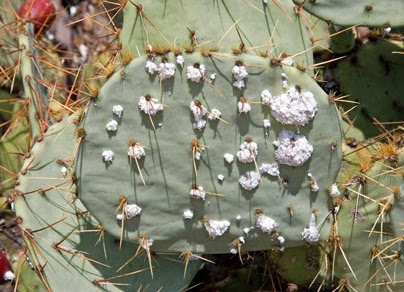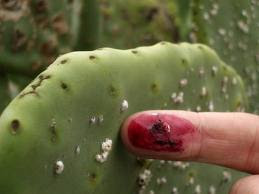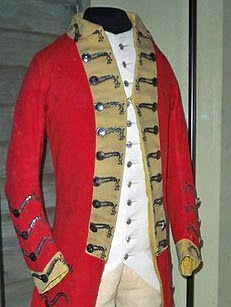Early travelers who visited our part of the world wrote without exception that this was a land blessed with natural resources.
One of those resources which early Texans sought to exploit was a color. Red.
Before the discovery of aniline dyes in the 1850s and 60s, the world was a pretty drab place for average people. The means for coloring your world were rare and expensive. Especially red.
So what was the source of this Texas red?
Go find some prickly pear cactus. You’re looking for pads covered with a white fluff.

Dig into the fluff and you will find a small insect. His name is Cochineal. Pull him out. Now squeeze him between your fingers. You will find them covered in a vivid red.

That’s carmine or carminic acid. From the sixteenth century until those cheap, bright aniline dyes, derived from coal tar, came along, the world was crazy for it.
Col. Juan Almonte, on his inspection tour of Texas before the Revolution, noted that there was much potential for the development of the cochineal industry. The twice yearly crop was already being gathered and hauled to Laredo to be sold, ultimately, to agents of the British crown.
What did the Brits want with these bugs? They where what made the Red Coats red.

They also supplied the red for Indian blankets and war paint. It colored the crimson sashes of Texas Army officers. And, when the Lone Star flag was adopted in 1839, the red field was bug red. This was nothing unusual. The red stripes on just about every American flag before the Civil War were dyed with cochineal.
It was even used in medicine. In 1854, Josiah Camillis Massie, a physician and planter residing near Channelview, produced the first medical book written in Texas: A Treatise on the Eclectic Southern Practice of Medicine. Within its pages he included a prescription for treating whooping cough in infants and children. It contained cochineal…along with ammonia, licorice, ipecac and opium.
Despite it’s potential, the cochineal industry never reached its potential in Texas. The Oaxacans had developed cultivation secrets, but were not eager to share them, especially after that whole independence business. Then came the aniline rainbow, and the cochineal industry died. Or went to sleep.

Over the last several decades demand has grown steadily. People in search of natural and environmentally friendly colorants have rediscovered cochineal. Only now it is more likely to be found in your mouth than on your clothing.
Read the ingredient label on a box or can from your pantry. If you see Natural Red #4, (or just ‘natural coloring’ in a red tinted product,) that is our little friend.
Is it time for Texas take part in the new cochineal boom? Maybe someday Landmen will be on the hunt for bug leases.
Categories: Texas Culture, Texas Folkways
